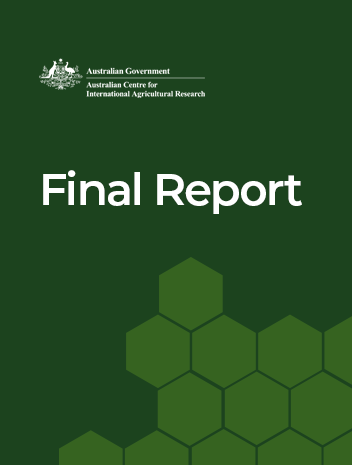- HomeHome
-
About ACIAR
- Our work
- Our people
-
Corporate information
- ACIAR Audit Committee
- Commission for International Agricultural Research
- Policy Advisory Council
- Agency reviews
- Executive remuneration disclosure
- Freedom of information (FOI)
- Gifts and benefits register
- Information publication scheme
- List of new agency files
- Contracts
- Legal services expenditure
- Privacy impact assessment register
- Commonwealth Child Safe Framework
- Benefits to Australia
- Careers
- 40 years of ACIAR
-
What we do
- Programs
- Cross-cutting areas
- Resources
- Where we work
-
Funding
- Research projects
- Fellowships
-
Scholarships
- John Allwright FellowshipScholarships to study in Australia for ACIAR partner country scientists to have Australian postgraduate qualifications
- ACIAR Pacific Agriculture Scholarships and Support and Climate Resilience Program
- Alumni Research Support Facility
- Publications
- News and Outreach
Project final report
Role of groundwater in agrarian change in West Bengal and Bangladesh: A comparative analysis - Final report
Date released
22 December 2021
ISBN
978-1-922635-84-6
Publication Code
FR2021-072
Overview
This project aimed to document the trajectory of agrarian growth in Bangladesh and West Bengal from the early 1990s onwards and examine the role of groundwater irrigation in that growth.
Agrarian change in Bangladesh and West Bengal has been a topic of great interest for researchers. West Bengal and Bangladesh share similar agro-ecology and culture, but have different policies and institutions, and this has led to a large number of studies comparing agrarian change and transition in the two places.
The higher rate of agricultural growth in West Bengal as compared to Bangladesh till the end of 1980s has been attributed to land reforms undertaken in West Bengal. However, these comparative studies do not go beyond mid 1990s. Since then, Bangladesh’s agricultural growth rate has surged ahead, and that of West Bengal has stagnated. The role played by groundwater in the overall agrarian growth in the region has not been adequately reflected in the literature.
Project outcomes
- Identified the trends of agricultural growth through a systematic review of published studies for the period from 1970s to recent time and summarize those results to understand the main drivers of those trends.
- Charted the trends in agricultural growth, growth in summer (boro) paddy production and changes in groundwater irrigation (area coverage and number of groundwater structures) in Bangladesh and West Bengal using secondary district/province level data from early 1990s to recent years.
- Compared growth in agriculture through a combination of review and secondary data analysis, and teased out the role of groundwater irrigation and energy policies in that growth/change.



